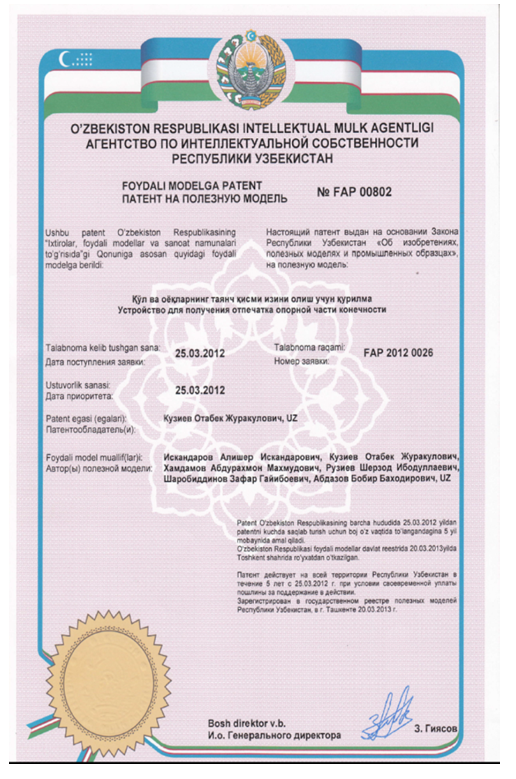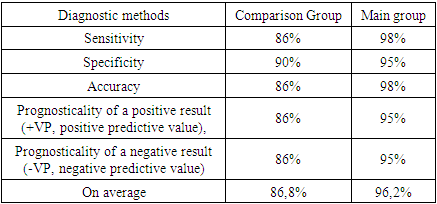-
Paper Information
- Previous Paper
- Paper Submission
-
Journal Information
- About This Journal
- Editorial Board
- Current Issue
- Archive
- Author Guidelines
- Contact Us
American Journal of Medicine and Medical Sciences
p-ISSN: 2165-901X e-ISSN: 2165-9036
2022; 12(12): 1244-1247
doi:10.5923/j.ajmms.20221212.15
Received: Nov. 19, 2022; Accepted: Dec. 6, 2022; Published: Dec. 9, 2022

A Way to Improve the Efficiency of Fingerprint Identification in Forensic Medicine
O. Zh. Kuziev1, M. A. Yusupov2
1Department of Forensic Medicine, Tashkent Pediatric Medical Institute, Tashkent, Uzbekistan
2Department of Pathological Physiology, Urgench Branch of the Tashkent Medical Academy, Urgench, Uzbekistan
Copyright © 2022 The Author(s). Published by Scientific & Academic Publishing.
This work is licensed under the Creative Commons Attribution International License (CC BY).
http://creativecommons.org/licenses/by/4.0/

Methodological recommendations are intended for forensic doctors. These methodological recommendations present the results of the method of taking fingerprints, both in living people and in corpses, by staining the surface of the skin, using a sponge impregnated with stamp mastic, which is located in a specially designed case, in which the lower edge is specially designed to conveniently position the brush hands on a soaked sponge. Conducted research methods allow to obtain a more complete picture of the pattern of fingers, palms and evaluate the diagnostic information content of their number in a short period of time.
Keywords: Methodological, Ophthalmology
Cite this paper: O. Zh. Kuziev, M. A. Yusupov, A Way to Improve the Efficiency of Fingerprint Identification in Forensic Medicine, American Journal of Medicine and Medical Sciences, Vol. 12 No. 12, 2022, pp. 1244-1247. doi: 10.5923/j.ajmms.20221212.15.
1. Introduction
- As the results of various studies cited in the modern scientific literature show, dermatoglyphics is considered a source of complete and extremely reliable information [1,3,4,6,7]. Recent studies have shown that dermatoglyphics, in addition to determining the quantitative and qualitative characteristics of individuals, can help in determining (to a probable extent) the sexual and nosological characteristics of the object under study [2,9].In recent years, a number of articles on the study of palm finger patterns have been published in the literature. In particular, it is possible to cite the results of research in the field of anthropology, biology, medical genetics, ophthalmology, neurology, criminology and forensic medicine for early diagnosis [1,2,4]. The basis for this study is that the papillary patterns of the hands and feet are hereditary, i.e. They are associated with race, gender, functional asymmetry of the legs and arms and some hereditary diseases, have a certain age stability and do not undergo significant changes during life. [3,8].The morphogenetic nature of the signs of finger and palm dermatoglyphics determines their high objectivity and informativeness as markers of particular and general manifestations. This is very important in the field under study, since it will be important to use the dermatoglyphic method as an additional system of signs, taking into account the possibility of solving the problem, in addition to the basic identification methods.Taking into account the differences in dermatoglyphic indicators revealed in published studies depending on nationality [5], as well as the importance of determining these indicators for both clinical and forensic medicine [2,3,4,6], the study of these indicators in the population becomes an urgent and important task.The purpose of the study: to increase the accuracy of the determination of finger and palm dermatoglyphics by an easily accessible method of staining.
2. Materials and Methods
- The study is based on data from the study of the effectiveness of the proposed method of staining the skin surface among 150 people aged 18 to 55 years. This group of individuals was divided into 2 groups by blind sampling. The main group consisted of 100 persons to whom fingerprinting was performed using the developed method of fingerprinting, by staining the skin surface, using a sponge impregnated with stamp mastic, which is located in a specially designed case in which the lower edge is specially designed for the purpose of conveniently placing the hands on the soaked sponge. The comparison group consisted of 50 persons who used the roller method of applying printing ink.Technical conditions: when pressing simultaneously on a sponge impregnated with stamp mastic, separate finger, palm prints on the hands are obtained.With the help of this method, the quality of the drawing of skin lines is ensured due to the uniform distribution of stamp mastic over the entire surface of the fingers. With the help of this method, the quality of the drawing of skin lines is ensured due to the uniform distribution of stamp mastic over the entire surface of the fingers.
 | Figure 1. Optimized method of fingerprinting |
 | Figure 2 |
3. Results and Discussion
- The use of the invention makes it possible to obtain a more complete picture of the pattern of fingers, palms and soles and to assess the diagnostic informativeness of their number in a short period of time. With the widely used method of printing ink for fingerprinting, it is necessary to have forms of fingerprint cards, black printing ink of the highest quality, two smooth metal or glass plates for rolling out paint and a paint solvent (turpentine or gasoline). The fingerprinting table has a height of 1 m 10 cm (under the elbow of a person of average height), equipped with a drawer for storing the necessary equipment. The top cover of the table, measuring 50-60 cm, has edges cut at right angles to the plane of the lid. The printing ink is rolled out evenly with a roller on a plate (glass) (Fig. 3).
 | Figure 3. Roller method of applying printing ink when taking fingerprints |
 | Figure 4. Frequency of single and repeated fingerprinting |
|
4. Conclusions
- The technical result is that when pressing a sponge soaked in stamp mastic at the same time, separate finger, palm prints are obtained, both on the hands and on the feet.With the help of this method, the quality of the drawing of skin lines is ensured due to the uniform distribution of stamp mastic over the entire surface of the palms and soles. After that, fingerprints, palms and soles are applied on the form in order to create a fingerprint card. The use of the invention makes it possible to obtain a more complete picture of the pattern of fingers, palms and soles and to assess the diagnostic informativeness of their number in a short period of time. After receiving fingerprints, the stamp mastic is easily washed off with ordinary running water.
 Abstract
Abstract Reference
Reference Full-Text PDF
Full-Text PDF Full-text HTML
Full-text HTML